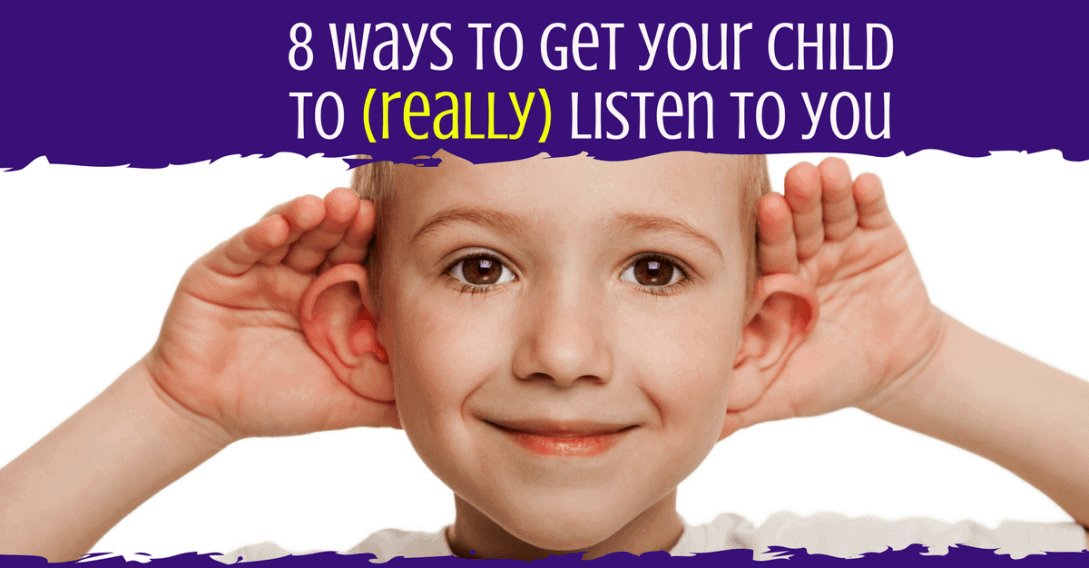8 Ways to Get Your Child to (Really) Listen to You
My sister and I remember the night our father woke us up to tell us the house was on fire.
Well, he didn’t exactly do that. Dad walked to the doorway of our bedroom and matter-of-factly said, “You need to get up, put your clothes on, and come down to the kitchen.” Then he left.
At 6 and 8 years of age—and super sleepy—we both just lay there.
Soon he was back in our room, now standing close by and sounding more intent: “The chimney in the living room is on fire. Get up now!”
Gee, Dad. Why didn’t you say that? In no time, the flashing firetruck was in the driveway, and we were up, dressed, and in a safe spot. Crisis averted.
Later, when my father discussed our inaction, he explained that he didn’t want to panic us. He also assumed we would do as we were told “the first time.” That logic aside, I think our wonderful Dad could have used some of the tips below on how to make sure your kids really hear you.
Connect before you communicate
Without doubt, it is best to talk to kids when you can make eye contact. In other words, be sure you are connecting before communicating.
When you want to be heard, don’t stand across the room. Get close, and look your child in the eye when possible. If engrossed in an activity (aren’t they usually?) make a little conversation to let him or her know you need their attention.
Kids respond in different ways. Some can shift gears easily, and others need more nudging to pay attention. In any event, you will be wasting your energy if your mouth is moving while a child’s mind is elsewhere. If you get no response, then start over by letting the youngster know that you realize she is busy—doing whatever that is—but make it clear you have something to talk about. Then, wait for a sign that you have her attention and proceed.
Tell them why you are talking to them
Children are better able to absorb what you are saying, and will be more responsive, if you give them a reason for what you are saying. Sure, it would be nice if they just followed through on what they are told. But since that is not a given, you will get a better response by explaining why you are asking for something. “I need you to put your book down now and get your backpack together so you can catch the school bus.”
Keep it focused
Make your message as brief as practical to avoid confusion. Stay focused on the issue. If the communication requires multiple steps, do not overload the child. Make sure he is able to follow what you say and can also remember what you have requested.
Try role playing
Until children have developed a habit of listening with attention when you address them, it can be helpful to role play. Let your youngster know that when you want to talk, you need three things:
- You need to have the current activity stopped;
- You want to have eye contact, and;
- You need him or her to LISTEN.
Acknowledge that it is not always fun to stop an activity midstream. But make it clear that this is what will be required when Mom or Dad is talking Act out a few scenarios and practice them together. You can also reverse roles to show what it is like to be ignored or only partly “heard.”
Don’t make your child dread it
Some kids seem have a good self-defense practice: They ignore unpleasant dialogue whenever possible. Or, they at least postpone it by turning a deaf ear for as long as they can get away with doing so. (Actually, adults are pretty good at this, too.)
If, based on your prior habits, your children think they are going to be yelled at, treated inconsiderately, or ordered around, it will take longer to gain their cooperation. When you communicate, do your best to speak in an understanding and supportive tone. Don’t make them cringe when they realize you have something to say to them.
Let your child know the importance of what you are saying though the tone of your voice and your choice of words. Aim to stay calm and direct.
Watch for recognition
After giving a message to your child, watch for confirmation that you were really heard. When it seems needed, ask for a repetition of what you have said. “Now, you please tell me. What is it that I need you to do?” Or, simply watch for subtle signs that confirm through some other means that what you said actually registered.
Set a good example!
Here’s a common but unfortunate scenario: A child wants to talk, yet Mom or Dad is engrossed in staring at a cell phone or tablet screen, and barely looks up.
Kids should be able to talk with a parent without having to often wait for Facebook to be checked, news updates reviewed, countless social texts and emails completed, etc.—not to mention a TV program finished.
If you want your child to listen to you, then return the favor. Train through your example. Put your screen down—or stop whatever your activity is if you can—and give some quality attention. Even a few minutes can make a big difference! In addition to modeling desired behavior, this practice will help keep valuable lines of communication open as your son or daughter gets older.
Reward good listening behavior
Words of gratitude and praise can go a long way to instill proper listening skills in children. “Thank you for stopping your play and talking with me.” For young ones who need special encouragement, a sticker chart to reinforce good listening is a helpful tool. You can download free printable incentive charts from our website and give your child a sticker or star to place on the chart at random signs of “good listening.”










